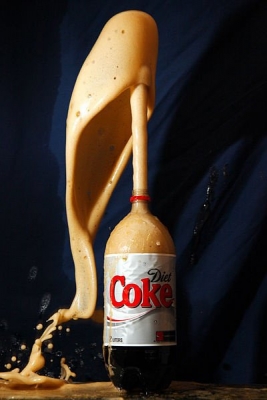
What you need:
A bottle of diet cola (the bigger the better)
A pack of peppermint candy
Paper
An open space outdoors where you can make a mess
What to do:
1. Make sure the bottle of diet cola is at room temperature before you begin this experiment.
2. Uncap the bottle and place it on the ground in the open space you’ve chosen.
3. We need to drop at least six peppermint candies into the bottle at the same time. For that you need to roll up a sheet of paper so that it can hold the Mentos candies
4. Place your thumb at the mouth of the paper roll so the candies don’t pop out as you position them over the mouth of the bottle. 5. Release your thumb, drop the candies in, and run!
What happens:
A foaming geyser erupts from the bottle of the diet soda. (It may soak you up too and leave you smelling of candied cola. Just be glad this is diet cola and not the regular one so you’re spared the stickiness of sugar.)
Why?
The reaction between the peppermint candy and the diet cola is not a chemical one. Instead, it is a physical reaction.
Have you ever tried dropping something in your fizzy drink-a piece of ice, maybe even a raisin. You see tiny bubbles coating the surface of these objects when they are dropped in the drink. This is because there is a lot of carbon dioxide dissolved in fizzy drinks. When the soda is opened, some of this gas escapes, but the rest stays in the liquid. That doesn’t mean it wants to stay though. The gas is always looking for a way out. And that’s why it loves rough surfaces. Because then it can form bubbles which attach themselves to that rough surface, rise to the top of the liquid the top of and poof away. This process by which a gas forms bubbles on a rough surface is known as nucleation.
Peppermint candy may look smooth enough but it has a lot of tiny bumps on its surface. Thus the carbon dioxide bubbles all rush towards it and start clinging to it. But the candy is heavy and instead of moving up, it moves to the bottom of the bottle. By doing so, it gets time to cover a lot more liquid, causing more and more bubbles to cling to it and turn into raving, raging foam that pushes the liquid of the bottle with incredible force.
Picture Credit : Google




